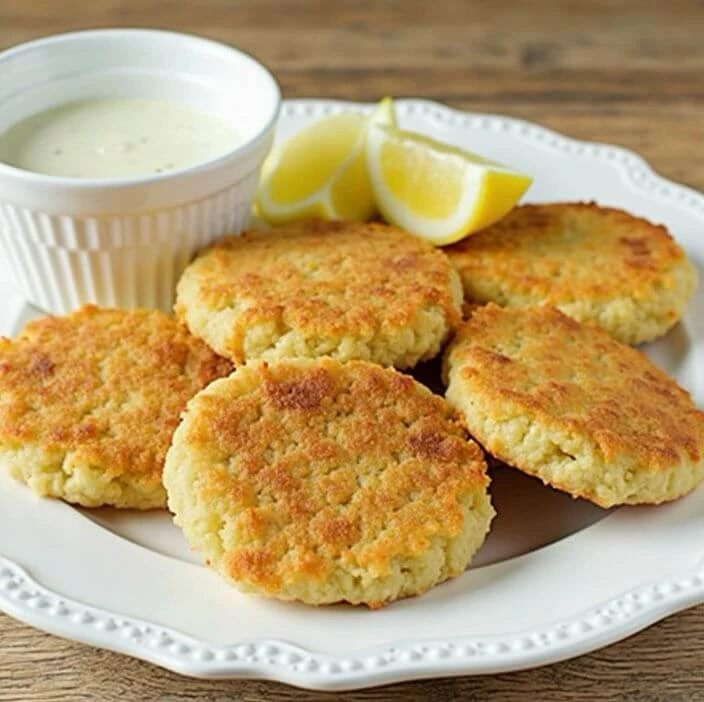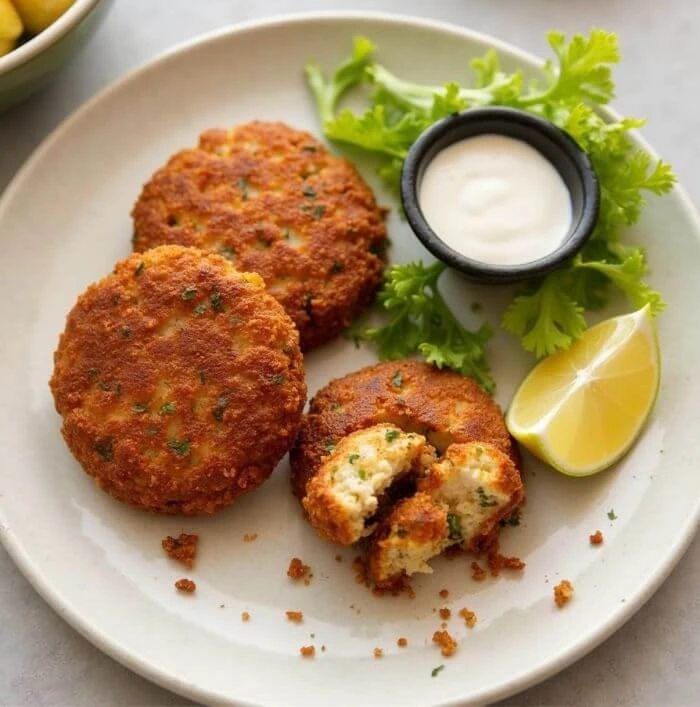Fish Cake Recipe: How to Make Crispy Cakes at Home
You know that feeling — the satisfying crunch of golden-brown crust giving way to a tender, flavorful center. Fish cakes are more than simply a meal. They carry memories, warmth, and that unmistakable comfort food satisfaction. Whether you’re remembering a seaside meal or just craving something savory and satisfying, a fish cake recipe made at home brings it all together.
If you’ve ever thought fish cakes were complicated or only for restaurant menus, it’s time to think again. With just a few pantry staples and simple steps, you can create crispy fish cakes that look and taste like they came from a professional kitchen — all from your own stovetop.
In this guide, you’ll get everything you need to know about how to make fish cakes that are crisp on the outside, moist on the inside, and packed with flavor. Ready to dig in?
Table of Contents
Why You’ll Love This Fish Cake Recipe
Making fish cakes from scratch might sound fancy, but you’ll quickly see why this is one of the easiest and most satisfying meals you can make at home.
Crispy on the Outside, Soft on the Inside
The trick to a great fish cake? Texture. You want that golden crunch outside with a warm, flaky filling. No mushiness. No falling apart.This recipe guides you through the process to perfect it.
Budget-Friendly Ingredients
You won’t need anything exotic. You likely have most of the ingredients on hand already. It’s also the perfect way to repurpose leftover fish or potatoes.
Quick Enough for a Weeknight Dinner
From start to finish, you’ll be done in about 45 minutes — and most of that time is hands-off. Whether you’re feeding the family or meal prepping, it fits into your busy schedule.
Ingredients You’ll Need for Homemade Fish Cakes
Let’s break down everything you need in one place for quick prep. This table makes it easy to gather your ingredients.
Main Ingredients
| Ingredient | Quantity | Notes |
|---|---|---|
| cooked white fish | 1 lb (450g) | such as cod, haddock, tilapia, or pollock. |
| Potatoes (mashed) | 2 cups | Starchy potatoes work best |
| Egg | 1 | Helps bind everything together |
| Breadcrumbs | 1 cup | For coating only |
| Green onions | 2 stalks | Finely chopped |
| Garlic powder | 1 tsp | Or use 1 minced clove |
| Fresh parsley | 2 tbsp | Optional, adds freshness |
| Salt & pepper | To taste | Season according to preference |
| Oil for frying | As needed | Choose neutral, high-smoke oils |
Optional Add-Ins for Extra Flavor
- Chili flakes or cayenne for heat
- Dijon mustard for zing
- Lemon zest for brightness (if you like citrusy notes)
How to Make Crispy Fish Cakes at Home (Step-by-Step)

If you’re new to making fish cakes, don’t worry. This isn’t complicated. Just follow the steps, and you’ll have delicious, crispy fish cakes in no time.
1. Prepare Your Base
Start with cooked fish and mashed potatoes. Break the fish into small flakes using a fork. You want pieces that blend well but still give texture.
- If using fresh fish: Steam, bake, or poach it before flaking
- If using canned fish, make sure to drain it well and flake it with a fork.
2. Mix the Filling
In a large bowl, combine:
- Flaked fish
- Mashed potatoes
- Egg
- Green onions
- Garlic powder
- Parsley (if using)
- Salt and pepper
Stir gently to combine. Don’t overmix — just enough to bring everything together without turning it into mush.
3. Shape the Cakes
Use your hands to form patties about the size of your palm, roughly ¾-inch thick. You should get 8 to 10 cakes from this batch.
Pro Tip: If the mixture feels too wet, add a tablespoon of breadcrumbs. If it’s too dry, add a splash of milk or another egg.
4. Chill to Firm Up
Place your formed cakes on a tray lined with parchment paper. Chill in the fridge for 20–30 minutes. This step is key. It helps them hold their shape during frying.
5. Coat with Breadcrumbs
Before cooking, press each cake gently into a plate of breadcrumbs, coating both sides evenly. Shake off any excess.
6. Pan-Fry Until Golden
Pour 2–3 tablespoons of oil into a non-stick pan and place it over medium heat.Once the oil is hot (but not smoking), fry the cakes in separate batches.
- Fry for 3–4 minutes per side
- Don’t crowd the pan
- Let each side crisp up before flipping
Drain on a paper towel after frying.
Top Tips for Crispy, Flavorful Fish Cakes
You don’t have to be an expert to make these, but a few helpful tips can really make a difference.
Pick the Right Fish
- Light, flaky white fish such as cod, haddock, or pollock work best.
- Steer clear of very oily fish unless you’re aiming for a bolder, richer taste.
- Canned tuna or salmon work in a pinch — just drain them well
Prevent Falling Apart
- Always use an egg for binding
- Chill your cakes before cooking
- Don’t flip too soon — let the crust form first
Best Oils for Frying
Stick to neutral oils with high smoke points like:
- Canola
- Sunflower
- Vegetable oil
Avoid butter — it’ll burn quickly and make the cakes greasy.
Serving Ideas: What to Pair with Your Fish Cakes

These crispy fish cakes are super versatile. They work as the main event or a flavorful side. Try these combos:
As a Main Dish
- Fresh green salad with vinaigrette
- Roasted asparagus or steamed broccoli
- Mashed peas or coleslaw
With Dips or Sauces
- Tartar sauce
- Spicy aioli
- Greek yogurt mixed with herbs and lemon
Creative Leftover Ideas
- Break into chunks for a fish cake sandwich
- Serve with eggs for a breakfast hash
- Serve over a bowl of rice or grains, topped with vegetables and your favorite dressing.
Variations to Try (Global Flavors You’ll Love)
Once you’ve nailed the basic recipe, try experimenting with flavors inspired by different cuisines.
Thai-Style Fish Cakes
- Add red curry paste, lime zest, chopped cilantro
- Serve with sweet chili sauce
Caribbean-Inspired
- Add thyme, Scotch bonnet peppers, and allspice
- Use saltfish or cod for authenticity
Mediterranean Version
- Include olives, feta, and oregano
- Serve with tzatziki or hummus
Make-Ahead and Storage Tips
Planning ahead? Fish cakes are freezer- and fridge-friendly.
To Store in the Fridge:
- Keep in an airtight container for up to 3 days
- Reheat in a pan or air fryer for best texture
To Freeze:
- Freeze uncooked cakes on a baking sheet
- Once solid, transfer to a freezer bag
- Cook from frozen, adding a couple extra minutes per side
FAQ: Fish Cake Recipe Essentials
What’s the best fish to use for fish cakes?
Cod, haddock, and other white flaky fish are perfect. They maintain their shape nicely and offer a subtle, pleasant taste.
Can I use canned fish in this fish cake recipe?
Yes, canned tuna or salmon works great. Just drain thoroughly and flake well.
Why are my fish cakes falling apart?
You may have skipped chilling or didn’t use enough egg to bind the mixture. Be gentle when flipping during cooking.
How do I keep my fish cakes from being too dry?
Use moist mashed potatoes and avoid overcooking. If the mixture seems too dry, stir in a little mayonnaise or milk.
Absolutely—you can bake or air fry them instead of pan-frying.
To air fry: Cook at 375°F (190°C) for 10–12 minutes, turning once for even crispness.
To bake: Place the cakes on a lined baking sheet and bake at 400°F (200°C) for about 15–20 minutes, flipping halfway through.
Conclusion: Bring Home the Crispy Comfort
Now you’ve got the tools, tips, and technique to master your own fish cake recipe. Whether you’re cooking from scratch or using leftovers, this dish gives you all the comfort of home with none of the hassle.
So go ahead — make a batch tonight. Play with the flavors. Serve them up with your favorite sides. Once you taste that crispy crust and tender center, you’ll understand why this recipe deserves a regular spot in your meal rotation.
Your Turn: Try It and Share
Ready to get cooking? Try this fish cake recipe and see just how easy it is to bring crispy, homemade comfort food to your table. If you love it, share it with someone who could use a simple and satisfying meal idea!
Have questions or want to share your variation? Drop a comment below — your fellow foodies would love to hear from you.

